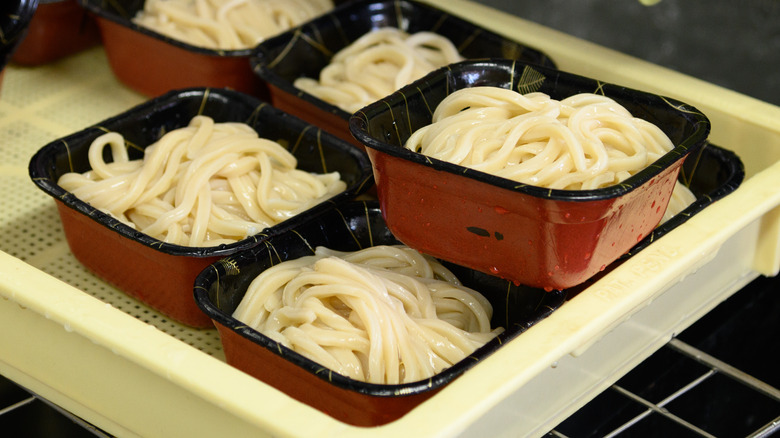What's The Difference Between Soba Noodles And Udon Noodles?
For centuries -– perhaps even millennia -– foodies from all corners of the globe have consumed noodles. This carb-loaded food was (and is) a staple for many people's diets, especially in parts of Asia, like Japan. According to The Japan Times, the first documented reference to "thin noodles" appeared in Japan around the 7th century. Hailing from China, these rice flour-based noodles were known as sōmochi, and were often enjoyed in Japan's Imperial Court during special events.
Centuries later, noodles with origins in Asian countries — again, like Japan — have grown popular around the globe, per The Japanese Times. Whether they're chewy udon noodles or something more of the tender soba variety (among other kinds), they come in a variety of shapes, sizes, and textures. However, some consumers may find it difficult to distinguish between soba and udon, two noodle varieties that are extremely popular in Japan, but perhaps not as popular as, say, ramen. Today, both soba and udon enjoy their respective places in the modern Japanese diet and have done so for centuries. Despite their mutual popularity, these two noodle dishes have distinct characteristics in terms of flavor, taste, shape, and color.
What are soba noodles?
Soba is a type of noodle thoroughly enjoyed as a staple in Japan, and typically made using buckwheat flour. According to japan-guide.com, soba noodles are often enjoyed as comfort food, but are also eaten when someone is under the weather due to their health benefits. As per Healthline, soba noodles are packed with more protein than Italian-style whole-wheat spaghetti noodles and contain a plant compound known as rutin. Rutin harbors potent antioxidant properties, which can help with cholesterol levels; it also has other benefits, including strengthening and flexibility of the blood vessels (which may ultimately aid in conditions related to blood clots), as well as helping to reduce arthritis pain.
There are a number of regional Japanese dishes that incorporate soba. For instance, toshikoshi soba is a common New Year's eve recipe in Japan, which symbolizes longevity for the new year, as MasterClass notes. In Kyoto, a local dish called nishin soba, which combines preserved herring with thin soba noodles, also enjoys more widespread popularity in the country, per japan-guide.com. These tasty noodles are eaten cold during the hot summer months and hot during the cooler months, making them a versatile staple.
What are udon noodles?
Udon is a Japanese noodle made with wheat-based flour. Generally speaking, udon noodles are thick in size, chewy in texture, and lighter in color due to the flour they're made with. According to MUSO, a Japan-based food retailer, these tasty noodles are said to be "easy" on the stomach and are also seen as a comfort food when someone is sick due to their quick digestibility. Udon can also be eaten hot or cold — but regardless of which, udon noodles are usually served alongside a savory broth.
Considering these noodles are popular all across Japan, it's safe to say they're incorporated into a number of regional dishes, which are all unique in their own right. For instance, as explained by the food and travel site Tsunagu Japan, it's common to enjoy Mizusawa udon, a type of udon noodle made using local wheat flour and natural spring water, in one of Japan's rare landlocked regions. Meanwhile, in the Akita Prefecture, a northern region in Japan, locals gravitate toward inaniwa udon, a thin variety that takes four days to prepare, as explained by Ogawa Udon, a Japanese brand that manufactures these regional noodles.
What's the difference between udon and soba?
As stated by the Japan National Tourism Organization, soba and udon are enjoyed year-round in Japan, commonly found in both udon and soba restaurants. Despite sharing some similarities, both noodles remain uniquely distinct. Specifically, their core differences are found on their ingredient list: While udon is made using wheat flour, soba is traditionally made with only buckwheat flour. However, according to japan-guide.com, restaurants often find it difficult to make soba noodles using 100% buckwheat flour because of its brittle nature. That's why it's common for soba noodle makers to add wheat flour to the dough, for easier preparation.
Aside from their ingredients, udon and soba noodles also differ in color, taste, and texture. While udon noodles are white, light-tasting, and chewy, soba noodles are, in contrast, brown, nutty (with subtle bitter notes), and firm in texture, as summarized by the retailer and blogger Nona Lim.
Lastly, soba may appeal to foodies with certain dietary needs. For example, according to Healthline, soba made from 100% buckwheat flour is a delicious gluten-free substitute for consumers with gluten sensitivities. However, Thermo Fisher's Allergy Insider claims that soba may cause allergic reactions in consumers, particularly those with buckwheat allergies.



